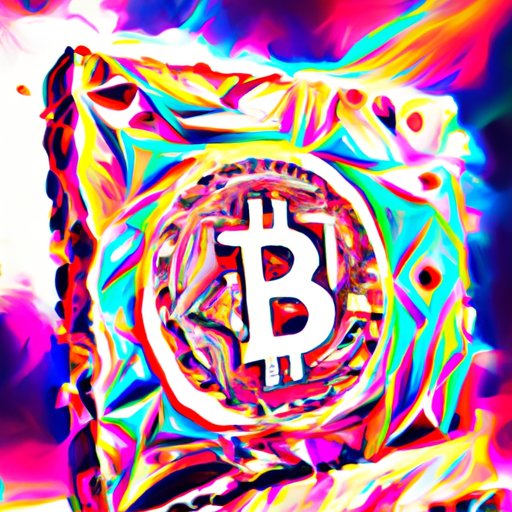Introduction
Crypto art has become increasingly popular in recent years, with many artists turning to this new, digital medium as an exciting way to express themselves and share their work with the world. But what exactly is crypto art? And how is it impacting the creative scene?
In general terms, crypto art is artwork that has been created using blockchain technology. It is a form of digital art that utilizes cryptographic protocols and distributed ledger technologies, such as Ethereum and Bitcoin, to record and store ownership information, create unique digital artwork, and facilitate the exchange of art between buyers and sellers. As a result, crypto art has transformed the traditional art market and opened up new opportunities for artists and investors alike.
This article will explore the concept of crypto art in greater detail, including its history, the rise of crypto art, how to get started with digital art, and the future of this innovative medium.
History of Crypto Art
Crypto art has been around since 2017 when the first non-fungible tokens (NFTs) were created. NFTs are digital assets that are stored on the blockchain and can represent a variety of digital assets, such as images, videos, audio files, 3D models, and more. The use of NFTs enables artists to create unique digital works that are protected by copyright law and can be bought and sold on the open market.
The rise of crypto art has had a tremendous impact on the creative scene. For example, it has given independent artists the ability to take control of their own work and make a living from their art without relying on traditional galleries or other middlemen. Additionally, it has allowed artists to reach a much larger audience than ever before, as the art can be shared and traded across the globe.
Who creates crypto art? A wide range of artists, from traditional painters and sculptors to digital illustrators and animators, have embraced this new medium. There is a growing demand for crypto art, especially from tech-savvy collectors who appreciate the uniqueness of each piece and the potential for investment. Common types of crypto art include digital paintings, 3D models, animations, music, and more.

The Rise of Crypto Art
The popularity of crypto art has grown exponentially in recent years, thanks in large part to the emergence of blockchain technology. Blockchain allows users to securely store and transfer digital assets, making it ideal for tracking ownership of digital art. This has enabled a whole new market for digital art, with platforms like SuperRare and MakersPlace allowing buyers and sellers to directly engage in transactions.
In addition to providing a secure platform for trading digital art, blockchain technology also offers a number of other benefits. For instance, it allows artists to easily track the sales of their art, giving them greater control over their intellectual property rights. Furthermore, it helps to ensure that the art is truly unique, as each piece is registered on the blockchain and cannot be replicated.
The advantages of blockchain technology have made crypto art an attractive option for both artists and investors. For artists, it provides an avenue for earning a living from their work, as well as the opportunity to reach a global audience. For investors, it offers the potential for high returns, as the value of a piece of art can increase significantly over time.

An Introduction to Crypto Art
If you’re interested in getting started with crypto art, there are several steps you’ll need to take. First, you’ll need to find a platform that supports digital art and allows you to purchase and sell art using cryptocurrency. Platforms like SuperRare, MakersPlace, and OpenSea are all popular options.
Once you’ve chosen a platform, you’ll need to create an account and purchase some cryptocurrency. From there, you’ll be able to browse the available art and make purchases using your cryptocurrency. You can also create your own art and list it for sale on the platform.
If you’re new to crypto art, there are a number of resources available to help you learn more about this innovative medium. Online tutorials and video courses can teach you the basics of creating and selling digital art. Additionally, websites such as CryptoArt.net provide up-to-date news and information on the crypto art market.
The Future of Crypto Art
As the crypto art market continues to grow, it is likely that more artists will embrace this medium, creating a vibrant and diverse art scene. Additionally, the use of blockchain technology is likely to expand, enabling artists to better protect their work and ensuring that their creations remain unique and authentic.
However, there are also potential challenges facing crypto art. For example, the art market is becoming increasingly saturated, making it difficult for new artists to stand out. Additionally, the volatility of cryptocurrency could make investing in crypto art a risky endeavor. Finally, the lack of regulation in the crypto art market could lead to scams and fraud.
Conclusion
Crypto art is a relatively new and innovative medium that is revolutionizing the creative scene. It has enabled artists to take control of their work and make a living from their art, while also providing investors with the potential for high returns. With the emergence of blockchain technology, crypto art is set to continue its rapid growth in the coming years.
In summary, crypto art is a new and exciting medium that is transforming the traditional art market. It provides artists with the opportunity to reach a wider audience and make a living from their work, while also giving investors the chance to invest in digital assets with the potential for high returns. Ultimately, crypto art is here to stay.
(Note: Is this article not meeting your expectations? Do you have knowledge or insights to share? Unlock new opportunities and expand your reach by joining our authors team. Click Registration to join us and share your expertise with our readers.)
